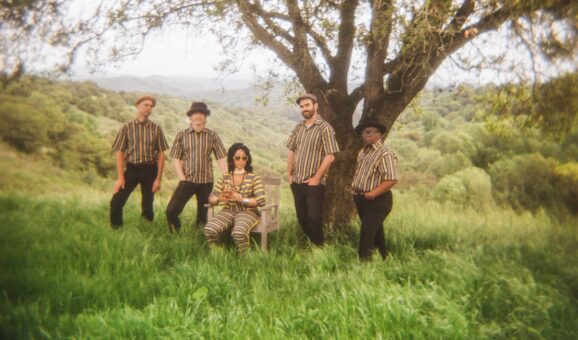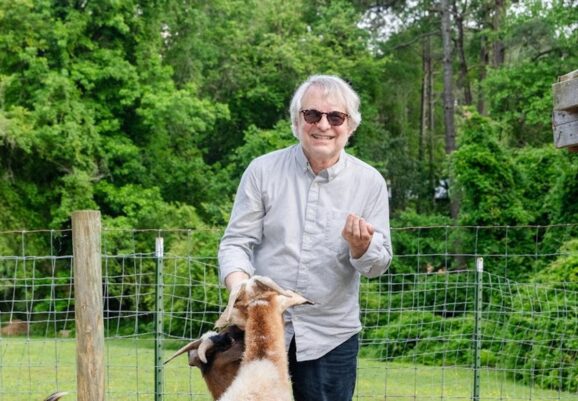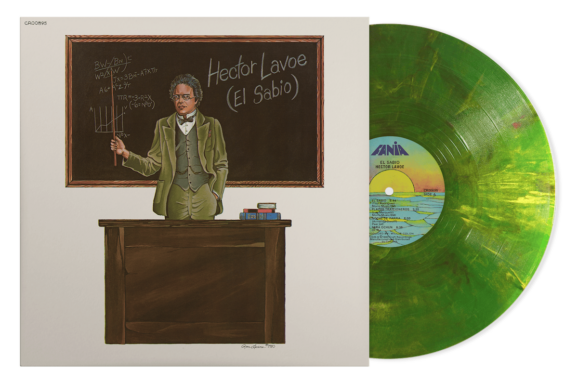North Carolinian songwriter, vocalist, guitarist, and Producer Chris Stamey’s new album, Anything Is Possible, arrived in multiple formats on July 11th, and he’s been busy with a series of performances bringing the album’s intricate sounds to audiences. It’s almost entirely original content (the outlier is Brian Wilson’s “Don’t Talk (Put Your Head on My Shoulder”), which conjures the sounds of earlier eras but laces them with an electric edge that makes them feel timeless.
Stamey is known as the co-founder of the dBs, for his playing with Alex Chilton, and in Jody Stephens’s Big Star Quintet, as well as his newer project recording with The Salt Collective. The breadth of his career continues to lead to many collaborations, and Anything Is Possible features contributions from guests such as The Lemon Twigs, Pat Sansone (Wilco), Probyn Gregory (Brian Wilson band), and Marshall Crenshaw, among others. I spoke with Chris Stamey about how he approaches collaborations for live performance, writing and recording these new songs, and what he thinks you might hear echoes of the 1950s in his current work.
I see that you’ve set up your shows as more of a series of separate dates with different groups of supporting musicians in specific locales. Is that a more appealing approach to you?
The common thread in these different locations is that the musicians all read music, particularly the strings and wind. So, you can walk in, and there’s not the usual kind of fumbling around, where people are trying to play from memory. But I did a European tour about a year and a half ago where I was in a different city every night, and I’d just meet the players at sound check, where we’d run through everything. When you put the paper in front of people, and music comes out, it’s magic if you’re used to playing in a Rock band!
How detailed is the sheet music? Is it very exact?
It’s not quite as locked in as I may be making it sound. There are sections where it is improvised. It’s also not so strictly notated that it doesn’t sound different every time. It’s somewhere between Rock, Jazz, and Classical in that way.
How did you decide which songs you would work on for this album? Was there a selection process out of a wider body of material that you’d been writing?
I had maybe twenty melody sheets with melodies and chords worked out. I workshopped them with some players over the course of a few months here, in North Carolina, and then did a show with Wild Honey here in LA, where we played some arrangements that I had in mind for the record. I recorded maybe thirteen or fourteen of those songs, and then some of those dropped by the wayside as I was working on it, and we went back in and recorded more.
I started the record as a little more down-beat. Well, the word I would use is “crooner-y”. But maybe “crooner-ish”? Then I did some shows with my friend Mitch Easter, and opening for The Lemon Twigs, and that changed the shape of the record. It became a little more electric and a little more energetic.
I noticed the electric elements and was very interested by that, because those elements do shape the overall feel of the album. Was just hearing that possibility what made you want to do that?
It seemed like it was fun. I write these songs as kind of scripts, with a tempo, chord changes, and melodies. Then I think of it like going to make a movie when recording it, whereas live performances might be like a play.
Were there different stages to the recording of these songs, so that they were built up over time, or was recording handled mostly at the same time?
I think recording is somewhere between a sudden strike of lightning, and digging ditches. You hope for the lightning strikes, and you get as much as you can, but then you dig ditches for a while. So there might be a song like “After All This Time” where the core band performance of it was pretty much live, and pretty simple and sparse, but then I did write a string and wind orchestration for it, to expand moments in it to be the same as I was hearing them. It may sound pretentious, but it’s like anybody does.
I think it’s fairly common for people to say that they are “hearing it” and they keep working until the recording sounds the same as it did in their mind.
I guess the difference is that there might be a bar where I can put in a viola, a cello, a violin, a flugelhorn, and a trombone, in a particular combination, and it’s a particular color. And when you’re writing it down on paper, you can be really controlled about that moment. Or you might also try to do the same thing with a pedal steel guitar, or percussion, and it might have a similar effect, but it wouldn’t be as detailed a moment, and not as precise a moment. I think that song is a good example of combining a live performance with pretty careful detailing.
That’s part of why it’s so great that you bring so many instruments to your live shows, which allows so much of it to come through.
Unfortunately, I use more instruments on my record than I can afford live!
Are you hearing those possibilities from the very beginning with these songs? Or is it springboarding off of sketches, which then drives new ideas?
It would have to be song-by-song, really, to discuss that. It’s difficult to talk about the creative process, because I’m really not there. It’s this other me that is doing it. My right brain is doing it. Then, afterwards, when I’m dialing up the left brain to talk to people about it, I try to say things that might have happened, but really, I’m no longer in that zone. It really is like that. I’m not sure what I was thinking at the time, but at the end of the day, I have my notes, and the paper, and melody written down.
As far as the specifics of what is on the record, there might have been three performances, back-to-back, by a band in the studio, and all of the same song, with the same chords, and the same tempo. But if one of them leaned a certain way, orchestrated for the record, it went a completely different way than the other takes, even though to a martian they’d sound about identical. You deal with what actually happened and what the players really brought to it. Like with movies, you have a script, but all of the sudden, Jack Nicholson opens his eyes really wide, and you realize you can use a different shot. You can also cut a page of dialog. It’s just part of it.
I think there are all kinds of ways to make good records, and I don’t want to say this is how to make records. I don’t want to be a “my way or the highway” kind of guy. I’ve made records that started with a drum machine, and were almost all sequenced, and had no real instruments on them. I’ve been really happy with those records. Maybe the most important thing is that the song is true to its own inner logic, so if it means a certain thing, even if that’s not really quantifiable, you try to achieve that.
It’s really about increasing the connection between the basic music and the lyric, because the kind of songs I’m talking about are hand-in-hand between words and melody. It’s possible to have a very sincere lyric, and make it sound completely sarcastic, or it’s possible to have a comical line, that just breaks your heart, depending on how it’s arranged. But you have to have that idea before you go in.
I noticed something of that kind with the song “Done With Love”, that it could have been taken in different ways and presented in different ways. The person is dramatizing their inner life so much, and it’s very emotional and archetypal. From an outside perspective, you can imagine a friend of this person saying, “Oh come on, you’re making too much of that.”
It does seem like that singer protests too much!
But the music doesn’t undermine the lyrics, raising questions of sincerity. The music supports the lyrics, I think. By early in the song, you’re relating to those thoughts and feelings, because they are real, even if they are of the moment.
Right, thank you. I ended putting that song on sort of near the end, and no one asked me about it, so it’s nice to talk about.
The sound is kind of meditative, too, and feels like an enclosed space. This person is feeling isolated, and there’s big drama in an enclosed space.
Thank you. I did the drums myself, kind of one at a time, a kick drum at one pass, a snare at one pass, a hi-hat, and everything. I think that give it a controlled feeling. There’s no one trying to push it forward. It’s just kind of steady, and maybe that’s what you’re talking about. For me, that song has harmonic things I like. Like the specifics of the melody against the chords, and the way it modulates into the organ solo. I also really love the organ solo. My friend Charles Cleaver played that, and it’s really perfect to me.
That definitely adds to the mood of the song. It almost gives extra weight to everything. That may be part of why it’s easy to take the mood seriously.
I’ll tell him that!
A very different song, but one with some points of contact to “Done With Love” is “Leaves in the Wind.”
That was not on the record until the very end. I guess that is maybe the newest song on it. I got really fascinated with this major 7 chord, with a sharp 11, called a “major 7, sharp 11”. Because it has that sharp note in it, it can pivot to other chords in a way that maybe some other chords can’t. It’s got this austere, open quality to it, so I really built the song around the chord, as much as anything else. In fact, that one was an instrumental that I recorded previously, called “Un Autre Temps”. I thought, “I love this. Let me make this into an actual song.” It was a recording on Spotify, meaning “another time.”
And it had a similar feeling for you to the lyric you later added?
Yes, and it really comes from the way the chords works.
I was struck by the unhurried pace of the song.
That’s true! It’s not in a hurry.
It feels like that works for the song’s lyric, because time is passing, but that’s not bringing the person to a better place, emotionally. The song mentions the hands of the clock, but it feels like an eternal state.
It seems frozen, yes. I was listening to a Chet Baker Sings album a lot. I actually asked the trumpet player, Probyn Gregory, from the Brian Wilson Band, to play like Chet Baker. He said, “Oh, I can’t do that!” But he actually sounds very much like Chet Baker.
I heard that you had a certain sound world in mind for this album, that of radio of an earlier time, where the songs were simple, but emotionally powerful. I don’t know if that’s something you noticed afterwards, or had in mind from the beginning.
I don’t know if I’d describe it exactly like that, but I figured that out afterwards. “Meet Me in Midtown” references “Downtown” by Tony Hatch, but also a song called “Hernando’s Hideaway” a little bit. The piano does something that’s on “Crosstown Traffic” by Jimi Hendrix. I thought that was kind of a period piece. There are other examples. It was really when I was looking at it, thinking, “What have I done?”, that I realized that was maybe the thread.
You mentioned the crooner aspect earlier, too. Was this something particular that made you want to participate in these kinds of sounds at this time?
A lot of the times when you’re playing the guitar, the way to go is to play chords that have three notes in them, but when you write on piano, as I’ve been doing, it’s easier to have chords with four or five notes in them. Once you hit four, you have more places to go from one chord to another, because you have more tones that can relate to more complicated chord progressions. So, for me, writing on piano now means that the chords are different.
That’s something that was similar to the 1950s era, when you had Bill Evans, and Wayne Shorter with Miles Davis, which kind of broadened the harmonic language, but was still very much related to Cole Porter, and that kind of basic four-note and five-note chord. That’s just been what I’ve been interested. I’m not trying to hold a flag up here, but I think it’s important to not stand still. I think it’s important to evolve if you’re doing creative stuff, and you’ve got to always watch that you’re not becoming a really good imitation of yourself.








